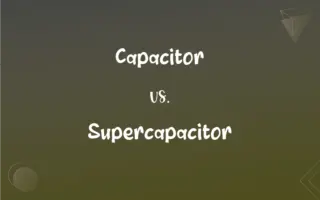Phyllode vs. Phylloclade: What's the Difference?
Edited by Aimie Carlson || By Harlon Moss || Updated on October 30, 2023
Phyllode is a flattened stem that functions as a leaf, whereas phylloclade is a branch that functions as a leaf.

Key Differences
Phyllode is a modified stem that takes on the function of a leaf, while phylloclade is a modified branch that acts as a leaf. Both are adaptations seen in plants to minimize water loss in arid environments.
Phyllode is typically seen in Acacia plants, where the true leaves are reduced and the petiole, or leaf stalk, expands to form a structure that functions as a leaf. Phylloclade, on the other hand, is seen in plants like cacti and some euphorbias, where the branch flattens out to perform photosynthesis.
Both phyllode and phylloclade are adaptations for photosynthesis in arid environments where water conservation is essential. However, while phyllode is a modified stem, phylloclade is a modified branch.
In summary, phyllode and phylloclade are both adaptations for photosynthesis in arid environments, with phyllode being a modified stem and phylloclade being a modified branch. They help the plant minimize water loss while maximizing the surface area available for photosynthesis.
Comparison Chart
Structure
Modified stem
Modified branch
ADVERTISEMENT
Example Plants
Acacia
Cacti, euphorbias
Occurrence
Seen in plants with reduced true leaves
Seen in cacti and some euphorbias
Function
Performs photosynthesis, minimizes water loss
Performs photosynthesis, minimizes water loss
Shape
Flattened leaf stalk (petiole)
Flattened branch
Phyllode and Phylloclade Definitions
Phyllode
Phyllode is an adaptation for photosynthesis in arid environments.
In the Australian outback, acacia trees with phyllodes are able to thrive despite the arid conditions.
ADVERTISEMENT
Phylloclade
Phylloclade helps minimize water loss in arid environments.
The flattened structure of the phylloclade reduces water loss in cacti.
Phyllode
Phyllode is a flattened leaf stalk.
The flattened structure of the phyllode allows for greater surface area for photosynthesis.
Phylloclade
Phylloclade is a modified branch that functions as a leaf.
Cacti have phylloclades that allow them to perform photosynthesis.
Phyllode
Phyllode is a modified stem that functions as a leaf.
The acacia tree has phyllodes instead of true leaves.
Phylloclade
Phylloclade is a flattened branch.
The flattened structure of the phylloclade allows for greater surface area for photosynthesis.
Phyllode
Phyllode helps minimize water loss in arid environments.
The acacia tree's phyllodes reduce water loss while still allowing for photosynthesis.
Phylloclade
Phylloclade is an adaptation for photosynthesis in arid environments.
In desert environments, cacti with phylloclades are able to thrive despite the arid conditions.
Phyllode
Phyllode is typically seen in Acacia plants.
The Australian acacia has large, flat phyllodes to capture sunlight.
Phylloclade
Phylloclade is typically seen in cacti and some euphorbias.
The Christmas cactus has phylloclades that are modified branches.
FAQs
What is a phylloclade?
A phylloclade is a modified branch that functions as a leaf.
What is the difference between a phylloclade and a true leaf?
A phylloclade is a modified branch that functions as a leaf, while a true leaf is a separate organ.
What are some examples of plants with phylloclades?
Some examples of plants with phylloclades include cacti and some species of euphorbia.
Can phyllodes perform photosynthesis?
Yes, phyllodes can perform photosynthesis.
What is the difference between a phyllode and a true leaf?
A phyllode is a modified stem that functions as a leaf, while a true leaf is a separate organ.
How does a phylloclade minimize water loss?
A phylloclade minimizes water loss by reducing the surface area available for transpiration.
What is a phyllode?
A phyllode is a modified stem that functions as a leaf.
Where are phyllodes commonly found?
Phyllodes are commonly found in Acacia plants.
Where are phylloclades commonly found?
Phylloclades are commonly found in cacti and some euphorbias.
Are phyllodes adapted to arid environments?
Yes, phyllodes are adapted to arid environments.
Are phylloclades adapted to arid environments?
Yes, phylloclades are adapted to arid environments.
How does a phyllode minimize water loss?
A phyllode minimizes water loss by reducing the surface area available for transpiration.
What are some examples of plants with phyllodes?
Some examples of plants with phyllodes include various species of Acacia.
How do phyllodes and phylloclades help plants survive in arid environments?
Phyllodes and phylloclades help plants survive in arid environments by minimizing water loss and maximizing the surface area available for photosynthesis.
What is the function of a phylloclade?
The function of a phylloclade is to perform photosynthesis and minimize water loss.
What is the shape of a phyllode?
The shape of a phyllode is a flattened leaf stalk.
What is the shape of a phylloclade?
The shape of a phylloclade is a flattened branch.
Can phylloclades perform photosynthesis?
Yes, phylloclades can perform photosynthesis.
Are there any other adaptations similar to phyllodes and phylloclades in plants?
Yes, other adaptations similar to phyllodes and phylloclades include succulent leaves and stems that store water.
What is the function of a phyllode?
The function of a phyllode is to perform photosynthesis and minimize water loss.
About Author
Written by
Harlon MossHarlon is a seasoned quality moderator and accomplished content writer for Difference Wiki. An alumnus of the prestigious University of California, he earned his degree in Computer Science. Leveraging his academic background, Harlon brings a meticulous and informed perspective to his work, ensuring content accuracy and excellence.
Edited by
Aimie CarlsonAimie Carlson, holding a master's degree in English literature, is a fervent English language enthusiast. She lends her writing talents to Difference Wiki, a prominent website that specializes in comparisons, offering readers insightful analyses that both captivate and inform.






































































